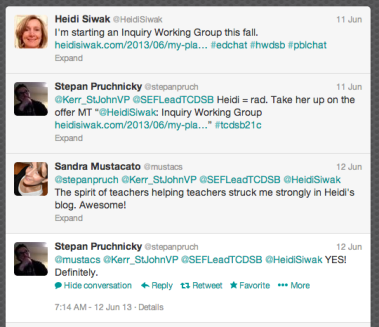Raising the level of teacher and/or student engagement is an ever popular topic. Many question how best to raise the level of engagement. I wonder though, should we even be asking that question? or more practically, maybe the question itself IS the problem.
Engagement can be a pretty one-sided venture. Depending on how you approach it, engagement could be viewed as a static activity whereby an individual is investing emotional energy into a fully formulated or prepackaged vision. When a canned board or ministry program is released to the education community, the goal is to engage the teachers and the learners. Success in this case is measured by how willing the participants are to get with the program and put it to work. Is this what we really want? Sounds kind of patronizing to me. Not to be trite or hyperbolic but doesn’t the “no taxation without representation” refrain of the pre-American Revolution times come to mind? You want my engagement but not my involvement in constructing the program or its implementation. Gee, thanks!
Rather than addressing the level of engagement, I think that we need to reflect on the level of participation. Many parts of our lived experience are so entrenched because there were no other options at the time of their creation. Educational programming has been top down in delivery and creation for so long because that made it easier to get the product to market. Connecting large numbers of people to contribute to an idea was either cost and/or location prohibitive. We see this model being chipped away daily thanks to the rise of connective technology. Rolling out a program without larger participation is no longer done out necessity, now it is a matter of choice. I am by no means suggesting that we run education referendum style where every decision or idea requires the consent or contribution of the entire education community. I do believe though that creation of policy and programs must become much more participatory in nature.
As an administrator, I believe it to be a fool’s mission to drop an idea on a staff without some form of participatory decision making. It doesn’t have to be the whole staff but using your School Improvement Team as key partners in the creation of policy is hugely important. It lifts moral since it doesn’t feel imposed but it also becomes a “smarter” venture because more ideas and viewpoints were added to the puzzle. This is not a difficult proposition because it is done within a single school. The challenge comes when you try to scale this type of participation to a system level. Connective technology makes this type of large scale participation possible. The doubters will claim that the level of participation will likely be low. SO WHAT? I am an administrator in the Toronto Catholic District School Board. We have approximately 9000 staff directly involved in learning (teachers, support staff and P/VP’s). Even if an open challenge initiative was to receive response from 1% of that population, that’s 90 people. Ninety new views, ideas or even idea fragments added to the pool of innovation. A slick campaign that combines substantive issues, good presentation design and heavy celebration of success is bound to attract more users with each iterative attempt.
21C is about opening up traditionally closed structures. It is about approaching problems from new and broad-based perspectives. It would be hypocritical to preach collaboration as a new world virtue to our students without doing it ourselves. This small example of a Twitter conversation has HUGE potential for student learning. An enlightened and open educator, Ms. Heidi Siwak puts out this amazing invitation and another amazing teacher Stepan Pruchnicky directs it to myself and the TCDSB SEF Lead Jan Murphy based on his knowledge of a collaborative inquiry of which we are a part. Sandra Mustacato from AICT joins and hopefully carries this on to her circle.
OpenIDEO scales this idea to a worldwide reach. IDEO partners with various NGOs, companies and non-profits to open large scale social problems to proposed solutions from the global community. The process is an intricate but accessible one, far beyond just throwing ideas at the wall and seeing what sticks. Ideas are put through a rigorous design process to reach a workable solution based on communal decision making.
E-waste is a global problem that should be open to a global response. The goal is not have people engage with a ready made solution rather the goal is for large scale participation. Education has always been a complex entity. We must start to harness the collective energy and ideas of our learning community. I truly believe that if we want 21C fluencies to take root and eventually bloom, we must cultivate a participatory culture. It is time to move way beyond engagement and think participation.



